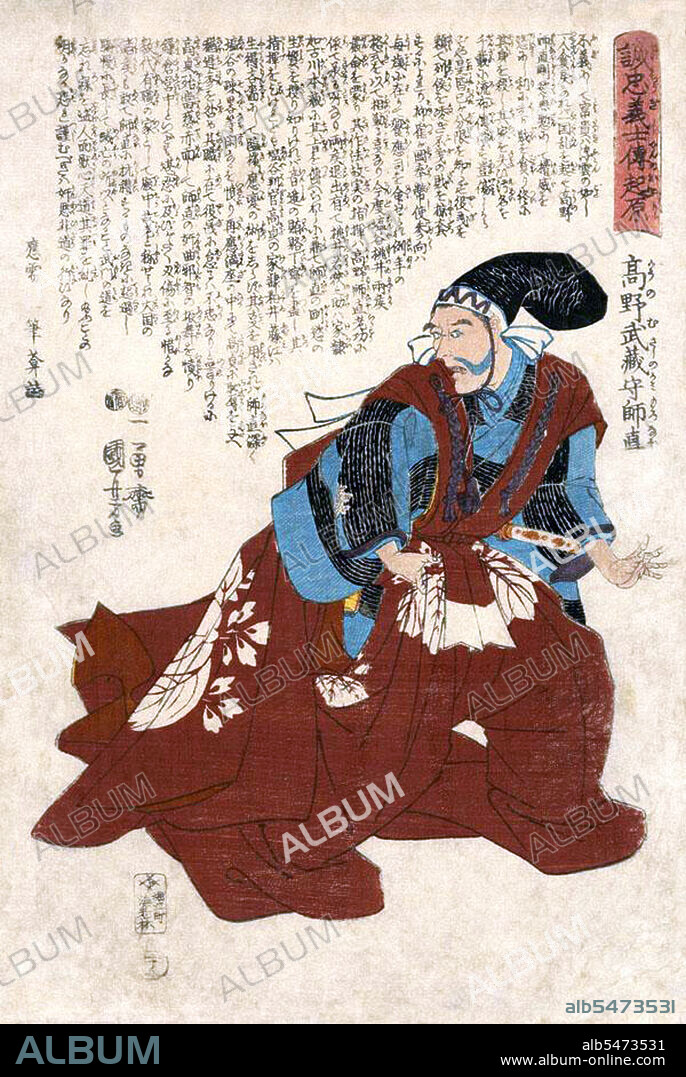alb5473531
Lord Kira Kozuke-no-Suke Yoshinaka cowering in terror at the attack of the 47 Ronin.

|
Añadir a otro lightbox |
|
Añadir a otro lightbox |



¿Ya tienes cuenta? Iniciar sesión
¿No tienes cuenta? Regístrate
Compra esta imagen

Título:
Lord Kira Kozuke-no-Suke Yoshinaka cowering in terror at the attack of the 47 Ronin.
Descripción:
Traducción automática: La venganza de los Cuarenta y siete Ronin (Shi-ju-shichi-shi), también conocidos como los Cuarenta y siete Samuráis, la vendetta de Aki o el incidente de Genroku Aki (Genroku aki jiken) tuvo lugar en Japón a principios de la siglo 18. Un destacado erudito japonés describió la historia como la "leyenda nacional" del país. Relata el caso más famoso relacionado con el código de honor samurái, el bushidi. La historia habla de un grupo de samuráis que quedaron sin líder (convirtiéndose en ronin) después de que su daimyo (señor feudal) Asano Naganori fuera obligado a cometer seppuku (suicidio ritual) por agredir a un funcionario de la corte llamado Kira Yoshinaka, cuyo título era Ki zuke no suke. . Los ronin vengaron el honor de su maestro después de esperar pacientemente y planear durante dos años matar a Kira. A su vez, a los ronin se les ordenó cometer seppuku por cometer el delito de asesinato. Con muchos adornos, esta historia real se popularizó en la cultura japonesa como emblemática de la lealtad, el sacrificio, la perseverancia y el honor que toda buena gente debe preservar en su vida diaria. La popularidad del cuento casi mítico sólo se vio reforzada por la rápida modernización durante la era Meiji de la historia japonesa, cuando se sugiere que muchas personas en Japón anhelaban regresar a sus raíces culturales. Los relatos ficticios de estos eventos se conocen como Chushingura. La historia se popularizó en numerosas obras, incluidas bunraku y kabuki. Debido a las leyes de censura del shogunato en la era Genroku, que prohibían la representación de acontecimientos actuales, se cambiaron los nombres de los ronin.
The revenge of the Forty-seven Ronin (Shi-ju-shichi-shi), also known as the Forty-seven Samurai, the Aki vendetta, or the Genroku Aki incident (Genroku aki jiken) took place in Japan at the start of the 18th century. One noted Japanese scholar described the tale as the country's 'national legend'. It recounts the most famous case involving the samurai code of honor, bushidi. The story tells of a group of samurai who were left leaderless (becoming ronin) after their daimyo (feudal lord) Asano Naganori was forced to commit seppuku (ritual suicide) for assaulting a court official named Kira Yoshinaka, whose title was Ki zuke no suke. The ronin avenged their master's honor after patiently waiting and planning for two years to kill Kira. In turn, the ronin were themselves ordered to commit seppuku for committing the crime of murder. With much embellishment, this true story was popularized in Japanese culture as emblematic of the loyalty, sacrifice, persistence, and honor that all good people should preserve in their daily lives. The popularity of the almost mythical tale was only enhanced by rapid modernization during the Meiji era of Japanese history, when it is suggested many people in Japan longed for a return to their cultural roots. Fictionalized accounts of these events are known as Chushingura. The story was popularized in numerous plays including bunraku and kabuki. Because of the censorship laws of the shogunate in the Genroku era, which forbade portrayal of current events, the names of the ronin were changed.
Crédito:
Album / Pictures From History/Universal Images Group
Autorizaciones:
Modelo: No - Propiedad: No
¿Preguntas relacionadas con los derechos?
¿Preguntas relacionadas con los derechos?
Tamaño imagen:
3400 x 5072 px | 49.3 MB
Tamaño impresión:
28.8 x 42.9 cm | 11.3 x 16.9 in (300 dpi)
 Pinterest
Pinterest Twitter
Twitter Facebook
Facebook Copiar enlace
Copiar enlace Email
Email
